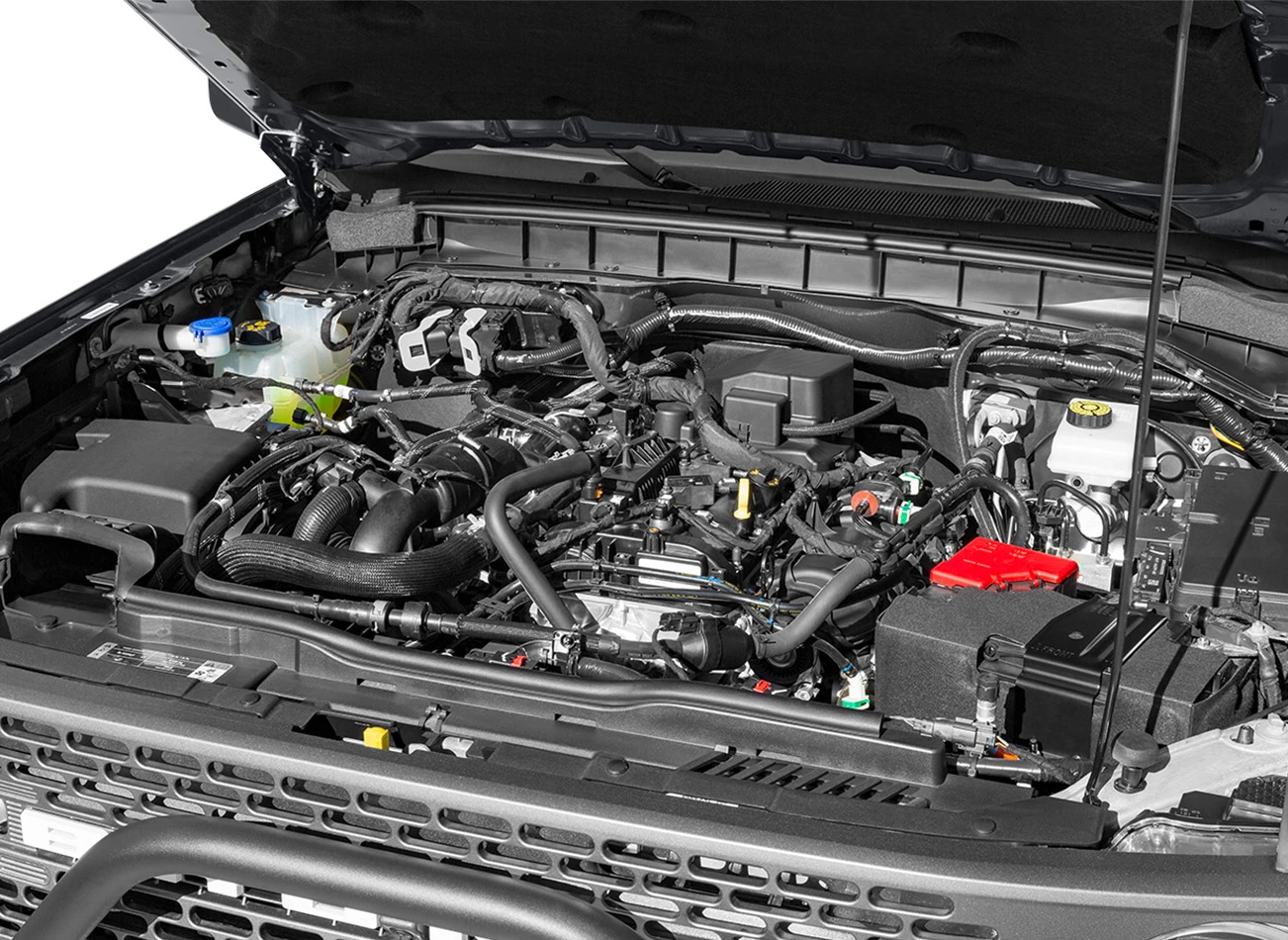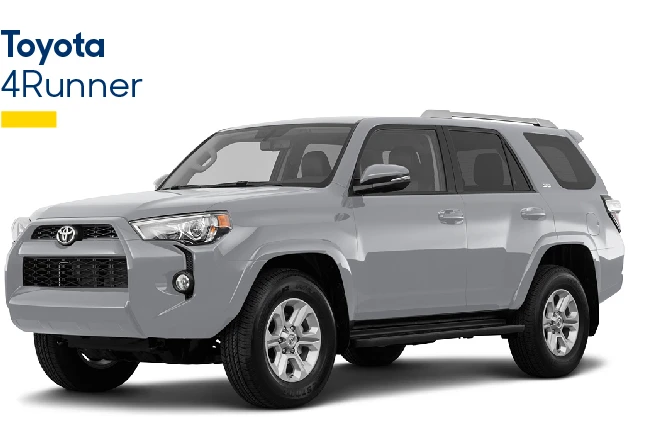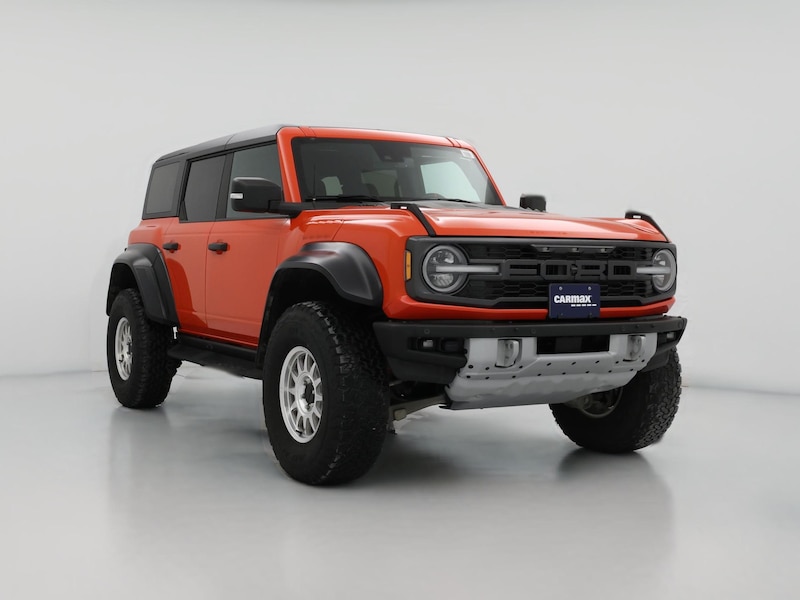2021 Ford Bronco review
Ford Bronco highlights
Customer rating
RepairPal reliability rating
(data not available)
Pros
- Chiseled, attractive exterior
- Two- and four-door options
- Removable roof and doors
Cons
- Unimpressive fuel economy
- Highway speed wind noise
- Rattles and vibrates off-road
Mileage (EPA estimate)
16 city, 17 highway, 17 combined
Pricing for current inventory
(no current inventory)
Shop with your budget in mind
Getting pre-qualified lets you shop with personalized monthly payments, and it doesn't impact your credit score.
Off-road capability, on-road charisma
After a 25-year hiatus, Ford brought back the Bronco as a capable and thoroughly modern SUV with serious off-road potential. The 2021 Ford Bronco delivers chiseled good looks, with a nostalgic nod to the original 1960s design, plus a modern and contemporary aesthetic that looks nothing like any other SUV on the road. When the weather is beautiful, you can get the full experience, as the 2021 Ford Bronco soft top comes off to make it an open-air convertible. Under the hood sits a choice of powerful engine options, with up to 330 horsepower to get through the deepest mud or the shortest on-ramp. The Bronco has plenty of options, including a rare-these-days manual transmission and a choice of two- and four-door body styles. The 2021 Ford Bronco Wildtrak trim can conquer it all, from crawling rocky terrain to fording rivers. From beautiful colors to impressive tech, here's what you need to know in our 2021 Ford Bronco review.
All Ford Bronco years
Not sure what year to select? Learn about each Ford Bronco generation from 2021 to 2026
2021 Ford Bronco trims
Curious how Ford Bronco trims differ? Use our side-by-side vehicle comparison to see the differences and similaritiesBase:
Includes 2.3L four-cylinder engine, 16-inch steel wheels, cloth seats, eight-inch touchscreen, five G.O.A.T (Goes Over Any Type of Terrain) driving modes, and more.
Big Bend:
Adds 17-inch alloy wheels, a sixth G.O.A.T. driving mode, LED fog lamps, matte gray grille, leather-wrapped steering wheel and shift knob, privacy glass, and three additional exterior colors.
Black Diamond:
Unlocks heavy-duty powder-coated front and rear bumpers, rock rails, skid plates, a seventh G.O.A.T. driving mode, 17-inch steel wheels, vinyl seats, waterproof flooring, and one additional exterior color.
Outer Banks:
Gains 18-inch alloy wheels, LED running lights, heated front seats, dual-zone climate control, available remote start, body-color exterior features, and more.
Wildtrak:
Adds 2.7L twin-turbo V6 engine, hood graphics, Sasquatch Package of locking front and rear axles, suspension lift, wider fender flares, and more.
Badlands:
Adds 17-inch machined-face alloy wheels, trim-exclusive suspension including electronic sway bar disconnect, additional G.O.A.T. driving mode for rock crawling, and more.
First Edition:
Unlocks 10-speaker Bang & Olufsen® sound system, exclusive leather interior, protective safari bar over the grille, and more. (Exclusive to this model year and limited to 3,500 vehicles)
Ford Bronco photos
5 reasons to buy the 2021 Ford Bronco
1. Radiates charisma

Every time you walk away, you'll turn back and look at the 2021 Ford Bronco because it looks that fun, even sitting still. You'll love the classic-yet-futuristic headlights, bold grille, fender flares, and repeated square theme in the body and windows. Pristine after a wash or coated with a thick layer of mud, the Bronco just looks great.
2. Strong engine options

The 2021 Ford Bronco lineup includes two different flavors of engine power, both packing a serious punch. The base engine starts with 300 horsepower, while the top trims offer 330 horsepower under the hood. You'll notice the power when cruising around town, powering through inclement weather, or making short work of mountain roads.
3. Seven great trims

Big Bend, Outer Banks, and Badlands are more than just locations for off-road adventures. These trims and four others offer the ability to get the exact Bronco you want. Want larger wheels, skid plates, and a dark chrome grille? Check. Looking for some luxury, with heated seats and a massive touchscreen? Bronco trims can do that, too.
4. Top-down driving

Not only does the 2021 Ford Bronco have a removable roof, but the doors are designed to come off, too. This offers wind in your hair when you're driving down the road, or maximum exposure on a backwoods trail. No worries about rain either, as the interior is filled with waterproof materials.
5. Off-road adventurer

If you enjoy the outdoors, whether hiking, glamping, fishing, or paddleboarding, Bronco is your new adventure buddy. When the roads are there in name only, the Bronco's short overhangs contribute to its impressive approach and departure angles, getting you out of any rut. Combined with 8.8 inches of ground clearance, you can go anywhere.
Similar vehicles
If you're interested in the 2021 Ford Bronco, you should also check out these similar vehicles from Previous generation years.

The truck-based Toyota 4Runner earned a reputation as an off-road SUV that can get you back from any wilderness adventure. 2017-2020 models are powered by a 4.0L V6 engine with 270 hp and 278 lb-ft of torque. The 4Runner also offers a surprisingly large interior for a midsize SUV, with plenty of room for passengers and cargo. The 2017-present 4Runner seats five comfortably, or there's 89.7 cu-ft in back with the rear seats down.
The 2017-2022 Toyota 4Runner TRD Off-Road impresses with:
Electronic locking rear differential
Kinetic dynamic suspension for increased wheel articulation
Sliding rear cargo deck

The Jeep Wrangler is a no-compromise off-road warrior that can also perform daily driving duties. The fourth generation (2018-present) Wrangler offers two- and four-door body styles with a removable roof and doors. Under the hood, you'll find a capable 3.6L V6 engine with 285 hp and 260 lb-ft. The 2020-present Wrangler also has a 3.0L diesel V6 engine option, and a plug-in hybrid and massive 6.4L V8 joined the options list for 2021.
The 2017-2020 Jeep Wrangler S is just off the base model, adding:
Power windows and locks
Automatic headlights
Heated exterior mirrors

Need some luxury with your off-road chops? The upscale yet classic good looks of the Land Rover Defender hide a powerful turbocharged 2.0L four-cylinder engine making 296 hp, or a 3.0L inline six-cylinder hybrid engine with 395 hp. Your seven passengers will love the charismatic interior, with exposed fasteners, switches instead of buttons, and exposed structural components. There's comfort here too, with supple leather, a head-up display, a 10-inch touchscreen, and a 14-speaker sound system.
The 2020-present Land Rover Defender SE includes:
Automatic headlamps
12-way power front seats
Driver's digital information display
Shop with your budget in mind
Getting pre-qualified lets you shop with personalized monthly payments, and it doesn't impact your credit score.
Ratings & reliability
Ford Bronco features and specs
Curious how Ford Bronco trims differ? Use our side-by-side vehicle comparison to see the differences and similarities
Wildtrak 2D Sport Utility 4WD/AWD
Standard Features
- Parking Sensors
- Rear Defroster
- Power Mirrors
- Cruise Control
- Smart Key
- Remote Start
- Rear View Camera
- Power Windows
- Power Locks
- Lane Departure Warning
- Traction Control
- Blind Spot Monitor
- Overhead Airbags
- ABS Brakes
- Front Seat Heaters
- Side Airbags
- Cloth Seats
- Air Conditioning
- Heated Mirrors
- Targa
- Hard Top
- 4WD/AWD
- Automatic Transmission
- Turbo Charged Engine
- AM/FM Stereo
- Satellite Radio Ready
- Apple CarPlay
- Auxiliary Audio Input
- Bluetooth Technology
- Android Auto
- Sync System
- Heated Steering Wheel
- Automated Cruise Control
- Rear Defroster
- Leather Seats
- Alloy Wheels
- Running Boards
- Full Roof Rack
- Tow Hitch
- Bang & Olufsen Audio
- Navigation System
Drive Wheels
Four Wheel Drive (4WD/AWD)
Engine size
2.7L
Horsepower
310
Torque (ft-lbs)
400
Engine type
Turbo Gas
Fuel capacity
16.9
Wheelbase
100.4"
Overall length
173.7"
Width
79.3"
Height
78.7"
Leg room
F 43.1"/R 35.7"
Head room
F 41"/R 39.8"
Front tires
LT315/70R17
Rear tires
LT315/70R17
Seating capacity
4
Max towing capacity
350/3500 lbs.
Transmission
Automatic
2021 Ford Bronco FAQ
Rock rails (also called rock sliders) are normally an aftermarket accessory that assists and protects your off-road vehicle. When traversing tall obstacles like boulders and downed trees, the Bronco's optional rock rails protect the bottom of the rocker panels and doors, giving the SUV a tough point to slide across the obstacle.
All 2021 Ford Bronco models offer a removable roof. The two-door model has three modular panels designed for easy removal. The four-door model comes standard with a soft-top that can be removed with included tools in approximately 10 minutes. Ford also offers an optional hard-top.
All trim levels of the 2021 Ford Bronco come standard with the Ford Co-Pilot360™ driver-assistance suite. Blind-spot monitoring is included in the package, alerting you when a vehicle is in your blind spot.
More about the 2021 Ford Bronco
Color options

Exterior colors:
Antimatter Blue (not available on First Edition)
Area 51 (not available on Base)
Cactus Gray (not available on Base)
Carbonized Gray (not available on First Edition)
Cyber Orange Metallic Tri-Coat (Black Diamond and higher trims)
Iconic Silver (not available on First Edition)
Oxford White (not available on First Edition)
Race Red (not available on Base or First Edition)
Rapid Red Metallic Tinted Clearcoat
Shadow Black (not available on First Edition)
Velocity Blue (not available on First Edition)
Interior colors:
Dark Space Gray with Navy Pier (blue) accents
Roast (brown) with Black Onyx accents
Interior details
Take one look at the 2021 Ford Bronco interior and you'll know it's built for off-roading. The frameless doors look unique and make for easier removal and storage in the rear. The overall dash design looks like it was inspired by a pickup, with a nice juxtaposition between the ultramodern large touchscreen and the classic and minimalist passenger side dash, complete with retro script Bronco lettering. The AC vents have a blocky vertical design that mimics the exterior, and you can change the temperature with the steering-wheel-mounted controls, a setting in the touchscreen, or the physical buttons below the screen.
The center console has plenty of storage, but you'll probably be distracted by the G.O.A.T. modes selector next to it. It works simply by rotating to your desired setting. The two-tone seats look great in cloth or leather and are comfortable enough for long road trips or slowly traversing harsh terrain.
The two-door Bronco seats four and has 22.4 cu-ft of cargo space behind the rear seats, or 52.3 cu-ft with the rear seats folded down. If you need maximum cargo, the five-passenger, four-door Bronco is your ride, with 38 cu-ft or 83 cu-ft of space with the rear seats down.
Child seat details
The 2021 Ford Bronco four-door SUV makes it easy to load and unload small children into their car seats in the second row. This includes LATCH car seats, infant car seats, rear-facing convertible car seats, forward-facing convertible car seats, and booster car seats. Note that the middle seat is narrow, so only booster seats are recommended there. LATCH points and lower anchors are easy to reach. The two-door model does require some gymnastics on your part to get the seat back there, but it connects as easily as in the larger model. If you have small children, you might lean toward the four-door Bronco for easy loading, but the two-door Bronco can serve you well, too.
Performance
The 2021 Ford Bronco's base 2.3L inline four-cylinder engine features a turbocharger, with 300 hp and 325 lb-ft of torque. Ford reports that this engine is good for a zero-to-60 mph time of 7.7 seconds with the 10-speed automatic transmission, or 8 seconds with the seven-speed manual (when new).
Stepping up to the optional twin-turbo 2.7L V6 engine, you get 330 hp and 410 lb-ft. The extra torque can help you sprint from zero to 60 mph in 6.1 seconds (according to the manufacturer, when new). That helps with merging into heavy highway traffic, but this SUV was built for off-roading. With 11.6 inches of ground clearance, the Ford Bronco can traverse obstacles that keep lesser SUVs restricted to the pavement. That raised ride height provides a great view of the road, in addition to 33.4 inches of water-fording capability. Top speed, when not fording water, is an electronically limited 106 mph.
Fuel economy comes in at an EPA-estimated 19 mpg combined with the base engine.
Maximum towing capacity is an estimated 3,500 lbs. with the V6, when properly equipped.Year comparison
2021-present Ford Bronco (sixth generation)
The Ford Bronco returned in 2021 after an extended break, now offering two- and four-door models. For 2022, the new Everglades trim sits between the Black Diamond and Outer Banks trims. It adds sweet features like a WARN® winch and Ford Performance intake snorkel. At the top of the trim range, the new 2022 Ford Bronco Raptor features a twin-turbo 3.0L V6 engine with 400 hp. The Bronco Raptor delivers high-speed off-road adrenaline with Fox™ adaptive dampers, increased ground clearance, and performance dual exhaust.
Research other vehicles
- Used Ford Bronco near me for sale
- Used 2021 Ford Bronco Sport near me for sale
- Used 2024 Ford Bronco Sport near me for sale
- Used 2021 Ford Bronco Sport Big Bend near me for sale
- Used Ford Bronco Sport with Memory Seat(s) near me for sale
- Used 2021 Ford Bronco Sport Outer Banks near me for sale
- Used Silver Ford Bronco Sport near me for sale
- Used 2021 Ford Bronco near me for sale
- Used Ford Bronco with 4 Doors near me for sale
- Used Automatic Ford Bronco near me for sale
- Used Gray Ford Bronco near me for sale
- Used Ford Bronco with Navigation System near me for sale
- Used Ford Bronco with Remote Start near me for sale
- Used Ford Bronco with Tow Hitch near me for sale
- Used Ford Bronco SUVs near me for sale
- Used Ford Bronco Sport SUVs near me for sale
- All things EV
- 2025 Ford Bronco review
- 2023 Ford Bronco review
- 2025 Land Rover Defender review
- 2025 Mercedes-Benz EQB 250 review
- 2024 Mercedes-Benz EQB 250+ review
- 2022 Mercedes-Benz Sprinter 2500 review
- 2023 Mercedes-Benz Sprinter 2500 review
- 2021 Nissan NV 1500 review
- 2021 Nissan NV 200 review
- 2021 Nissan NV 2500 review
- 2024 Porsche Cayenne E- PHEV review
- 2020 Porsche Cayenne Hybrid review
- Ram 2500
- Toyota 4Runner
- 2021 Toyota Land Cruiser review
- 2024 Toyota Land Cruiser review
- 2012 Toyota Matrix review
- 2018 Volkswagen Passat review
- 2019 Volkswagen Passat review
- 2020 Volkswagen Passat review
We hope you found this information helpful. This content is intended to inform and is not meant to indicate that a particular vehicle is currently available or recommended for you.
Statements of fuel economy or EV range are based on EPA and other third-party estimates for vehicles when new. Fuel economy and EV range will degrade with time and vary based on age, driving conditions, vehicle history, and other conditions. See fueleconomy.gov for more info.
Unless otherwise noted, information related to featured vehicles comes from third-party sources, including manufacturer information. Product and company names may be trademarks or registered trademarks of third-party entities. Use of them does not imply any affiliation with or endorsement by these entities. By clicking on any video links, you will be taken to a third-party site maintained by YouTube, Inc.
We make every effort to provide accurate information, but please verify before purchasing.















